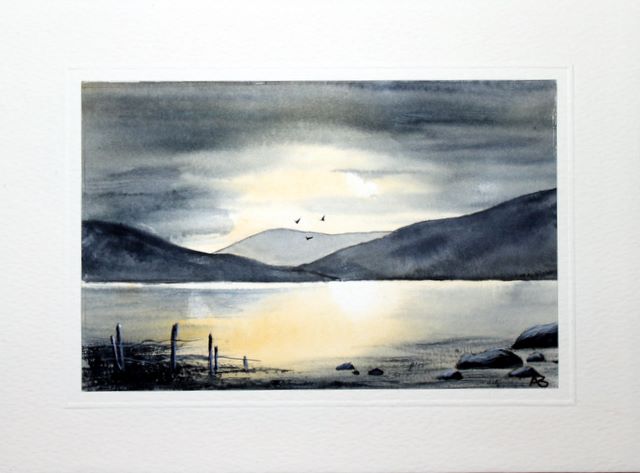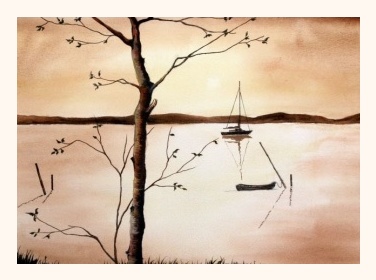Watercolour Materials and Tips
You need to plan your
painting and sketch it in very lightly and
accurately in pencil with minimal
disturbance to the paper (yes, I mean
rubbing out!) The exception to this would be
if you were doing wet in wet accidental type
paintings with no drawing.
Generally you have to wait for each wash to dry before continuing to paint. (You may find it is good to work on 2 or 3 paintings along together to avoid being idle while you are waiting, or use a hairdryer.)
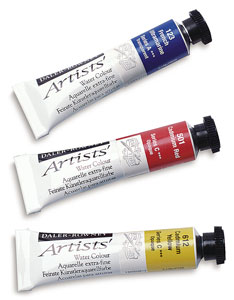
You need to be pristine
clean, with 2 water tubs – 1 for adding to the
paint (distilled preferably) and another for
washing your brushes.
Watercolours need to go
behind glass, with a mount so that the painting
does not touch the glass. Also a waterproof
backing is needed. This is to prevent mildew
over the years.
Various water based paints
have different qualities, such as: Acrylic –
which is no longer water soluble when dry and
comes in transparent, opaque and fluorescent
varieties
Gouache - which is opaque
water based paint, water soluble when dry - much
like the early poster paints. There is even a
range of water soluble oils available these
days.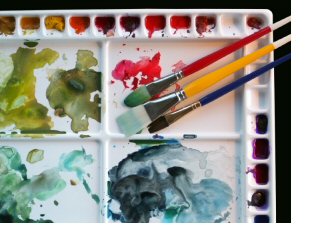
Watercolour pencils which give drawn lines or shading, but can form a paint when wetted with water via a brush.
Finally there are the Pure
Watercolours - which usually relates to finely
ground water soluble pigments. Watercolour
paints come in tubes and in pans
A Palette needs to have
dishes for mixing different coloured washes
before applying. If I were using the tubes, I
would put out the colours needed in the small
hollows and mix washes from them in the large
ones by taking a little paint across and adding
water.
Brushes need to be soft (usually
synthetic these days but I prefer to use pure
bristle) and hold plenty of paint.
The larger the painting, the bigger the brushes
needed – although some small ones for detail
will always always necessary
Large “mop-like” round
ferrule brushes are best for big washes – always
care for them by pointing them up after washing
& blotting – then store them handle down in a
container.
There are also watercolour pencils
available which are handy for
small "sketches" travelling studies.
Watercolour papers
come in different weights, smooth). Most are
acid free to help avoid mildew in the future.
Anything lighter in weight than 300 gsm needs
to be stretched so that it will not buckle when
washes are applied – so personally, I only buy
300 gsm.
With opaque paints
such as acrylic and oils, it is usual to work
from dark to light in establishing your
composition…however with watercolours it is the
other way around. You need to work
from light to dark, preserving the transparent
integrity of the washes
integrity of the washes
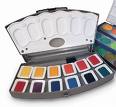
Sometimes it might be
useful to use masking so that you can apply
washes right across over and later peel off the mask to
reveal white paper. Mask comes as film
frisk in sheet form and masking fluid in a
bottle. g fluid in a
bottle.
Welcome to the Wonderful World of Water
Colour Painting 1.To begin painting with
watercolours, you'll need certain basic
supplies. When purchasing brushes, paint and
paper, avoid simply buying the cheapest
items, because these will be much
lower-quality supplies that will prevent you
from achieving the best results. You do not
need to buy the most expensive materials,
but look for a good compromise between
quality and price. After you have a set of
basic materials, you'll be ready to practice
your watercolour skills.
Round
Brush
2.Round brushes have narrow, round
tips, and they come in a variety of sizes,
indicated by numbers. Start with a size 8
round brush, and move up to a larger size if
you want to work on bigger paintings. Sable
hair is the highest quality brush hair, but
it is more expensive than squirrel or
synthetic hair. Look for a brush with a
combination of sable hair and synthetic hair
for a good compromise between price and
quality.
Oval
Wash or "Mop" Brush
3.Oval wash brushes have a large,
fluffy end for pre-wetting paper and
painting water washes. Look for a large flat
wash brush in goat hair or squirrel hair.
The hair quality of a flat wash brush
matters less than it does for other brushes,
because you will simply be using this brush
to spread water over your paper.
Flat
Wash Brush
4.Look for a ½- to 1-inch wide flat
wash brush for smaller washes and details.
Choose a wider brush if you will be working
on larger paintings. Look for an all-sable
brush or one with sable hair and squirrel or
synthetic hair.
Tube
Colours
5.Select primary tube colours in
warm and cool versions. You'll need warm and
cool versions of blue, yellow and red. You
can then mix almost any colour from these
colours. Purchase black and white paints if
you feel they are absolutely necessary.
Plastic
Palette
6.Choose a plastic palette with a
sealable lid to keep paints from drying out
between sessions. Look for a palette with
many individual paint cells around the edges
and a mixing area in the middle.
Paper
7.Choose a paper size, surface and
weight. A standard full sheet of watercolour
paper is 22 by 30 inches, but you can find
larger sheets if you wish. Surfaces range
from smooth (hot press) to textured (rough).
Medium texture (cold press) works well for
beginners. Paper weights range from 90 lb.
to 300 lb. Ninety pound paper cannot
withstand very much rubbing or wiping and
disintegrates easily. Begin with 140 lb.
archival, acid-free paper.
Paper Towels
8.Keep several rolls of paper
towels close by for blotting excess water
off of your painting or brushes and for
keeping your work area clean.
Pencils
9.Purchase several sizes of 2H
pencils for drawing thumbnail sketches. You
might also want to sketch on your
watercolour before you begin painting or
between sessions.
|






